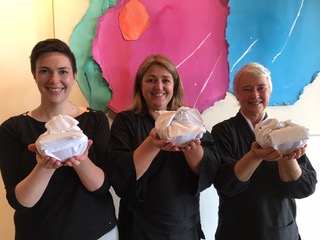In September, 2017, I packed all the belongings that I could fit into a rented Dodge Grand Caravan, left Green Gulch Farm/Green Dragon Temple, my home temple of practice and training for more than 10 years, and drove across the US—3,000+ miles and a seven day jour-ney that included crossing the Rockies, the Mississippi and Missouri Rivers, and wide expanses of farm land. I skirted the edges of cities, stopping only to sleep and for visits to the wondrous Water-Moon GuanYin in Kansas City MO, Sanshinji in Bloomington IN and the home of my dharma sister, Catherine Gammon, in Pittsburgh PA. I arrived in Brooklyn on a hot, humid late September afternoon.
Earlier in 2017 I had been invited by Brooklyn Zen Center/Boundless Mind Temple founders, Laura O’Loughlin and Greg Snyder, to join the BZC sangha (community) as Tanto (Head of Practice). I applied to San Francisco Zen Center’s Branching Streams for partial support to-ward a stipend for the initial six months of my tenure, and was grant-ed this support, which, with matching support from Brooklyn Zen Cen-ter, allowed me to accept Greg and Laura’s invitation.
Before I started my cross-country drive, I had located a new home, in Sea Gate, on the narrow southwestern tip of Brooklyn, where the Atlantic Ocean and New York Harbor meet. Several members of the Brooklyn Zen Center sangha were there to meet me when I parked the van in the driveway of a gracious Queen Anne Victorian. I very much appreciated their warm welcome (and their help in carrying my possessions up 3 flights of narrow stairs to the third floor apartment). I remember thinking “Zen students! It is wondrous what can be ac-complished by a few trained Zen students!”
On October 1, I entered my new practice home to learn the role of Tanto. As Brooklyn Zen Center is not residential, and sangha mem-bers have family and work commitments, the temple positions are held by pairs of volunteers—two Ino’s (Head of Meditation Hall), two Tenzo’s (Head of Kitchen), two Shika’s (Guest Manager), two Shissui’s (Work leaders). Given that, the responsibilities of the Tanto at BZC are shaped differently than at the residential centers of my training.
At BZC, the Tanto chairs the monthly Ryo meeting, where the Ino’s, Tenzo’s, Shika’s and Shissui’s and a representative of administration gather to discuss upcoming events and coordinate efforts. At my first Ryo meeting, we discussed the upcoming fall practice period, led by Guiding Teacher Teah Strozer, which included a Lay Entrustment cer-emony for Laura, a Jukai (Lay Bodhisattva Precepts ceremony) for 14 new Bodhisattvas, and a Stepping Down/Stepping Up ceremony wherein Laura and Greg would become the new Guiding Teachers. My first few months as Tanto were devoted to these ceremonies, as well as attending the regular Wednesday evening and Saturday morning programs, one day sittings and the sesshins (meditation retreat). I watched and I listened. I had been warmly welcomed by the sangha, and ceremonially offered the Tanto seat. Now it was my turn to meet the sangha, individually and collectively.
I felt encouraged that the sangha seemed to practice Soto Zen cere-monial forms with interest and enthusiasm, as overseeing formal practice was part of my job as well. I joined the after-service meet-ings of the doanryo (group that sounds the instruments in Zazen and service) and Ino in order to understand the BZC way with Soto forms and out of these meetings grew a weekly “doanryo training” time where sangha members would learn and practice the various roles of fukudo (who sounds the Han and the mokugyo), doan (who sounds the bells), kokyo (chant leader), and jiko (who carries incense during service).
In late January 2018, after the winter break, the new Guiding Teach-ers added a weekly Friday morning service to the weekly schedule. This expanded service includes the chanting of both the lineage of Zen ancestors and the female ācharyas (teachers), as well as The “Makka Hanya Haramita Shingyo” (Heart of Great Perfect Wisdom Su-tra) and other chants regularly a part of the San Francisco Zen Cen-ter morning service. Adding this service to the weekly schedule in-volved trainings on the mokugyo, additional doan forms and kokyo forms. At first, Greg, Laura, Ian Case and I held the roles of Doshi (ceremony leader), Kokyo, Doan and Fukudo. Now sangha members are trained and hold the doanryo roles each week.
About the same time, we began to offer the Bodhisattva Full Moon Ceremony on a monthly basis, with the principal roles held by the BZC leadership. The ceremonial roles are now held by sangha mem-bers.
In June, oryoki (ceremonial meal in the zendo during sesshin) prac-tice, including two meals in the zendo each day, was scheduled for Tenshin Reb Anderson’s five day sesshin. BZC has practiced a beauti-ful and mindful form of giving and receiving food in the dining room with regular utensils at tables. This form works very well, but during Rohatsu last December, the retreat attendance was such that the din-ing room did not hold all the participants, so the teachers and their attendants ate separately in their dokusan rooms. For Tenshin Roshi’s sesshin there would be fifty two participants. Practicing oryoki would allow BZC to accommodate all the people who wish to sit sesshin to eat together, so in January we began preparations. I had no idea the size of the endeavor when I accepted responsibility for its implemen-tation.
 
Oryoki sets made at Brooklyn Zen Center |
Bringing the ceremony of ōryōki to Brooklyn Zen Center involved and required the participation and effort of many of our members. We began in February to gather the equipment. Forty-five carved mango wood bowls and utensil sets were ordered. Several bolts of white cot-ton were measured, cut and hemmed for the forty-five oryoki sets. Utensil containers were hand sewn. Setsu’s (bowl cleaning utensil) were notched and cotton tips were made for each one. Serving pots, ladles, spoons and tongs were purchased, as well as small dishes, spoons and serving trays for offering gomasio (salt and sesame seed condiment). We bought teapots to carry the hot water to wash the bowls, and containers to receive the used water. And for those who sit meditation in chairs, folding tables were purchased.
When the equipment was gathered, trainings began. Each person in the sesshin was offered instruction in the detailed movements of the ceremony of eating ōryōki, learning how to open and set out the bowls. arrange the utensils, receive the food silently with hand sig-nals, clean the bowls and utensils, and re-wrap everything at the end of the meal.
Twelve participants in the sesshin were trained as servers, learning the movement patterns and serving techniques of the ōryōki tradi-tion. Later the servers learned and practiced the “servers’ meal”, in-structed by the Soku (Head of the serving crew).
The kitchen, led by the Tenzo, learned the forms used to prepare the food served, and the ceremony of offering the food to the serving crew.
On the first day of sesshin, 80 percent of the participants had never seen the ceremony of ōryōki, including the servers. I heard that Tenshin Roshi said later that he was amazed by the creative and unu-sual ways the participants initially found to organize and wrap their bowls. By the fifth day, the participants seemed to be practicing harmoniously with their bowls, utensils and cloths, and the servers were looking like the trained crews I have practiced with at Green Gulch Farm and Tassajara Zen Mountain monastery.
Practicing oryoki was an important marker in the process of matura-tion of the BZC sangha, and for me it was revelatory. Taking refuge in sangha was experienced in the process of transmitting the ceremo-ny of oryoki. We did it together—there was no separation.
The year has come fully around. After a more lightly scheduled summer, the BZC sangha has started the fall practice period with an opening ceremony, and a one day sitting. As Tanto, my responsibili-ties grow. I will now be meeting with people in practice discussion, leading some half day sittings, and I will co-lead with the Ino’s a do-anryo training retreat. There are weekly Practice Council meetings with Guiding Teachers, and monthly Priest meetings with the temple priests, Greg, Inzan Rose and Ian Case. Each day I gratefully walk the Bodhisattva Path, taking refuge in Buddha, Dharma, and Sangha.
I wish to express my deep gratitude to San Francisco Zen Center for their training and support, to Abbess Eijun Linda Ruth Cutts and Liai-son for Branching Streams, Steve Weintraub, who supported my aspi-ration to carry the training I received at SFZC to one of our Branching Streams. Great thanks to Greg Snyder and Laura O’Loughlin, Guiding Teachers of Brooklyn Zen Center, who invited me to Brooklyn Zen Center and warmly and generously welcomed me into the sangha, and to the Board of Directors and Administration of Brooklyn Zen Center for supporting me in this relocation of my life and practice from the Pacific Coast to the Atlantic Coast. One hundred and eight bows!
